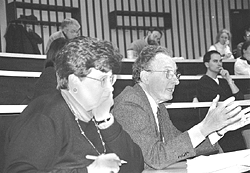

At Tuesday's college faculty meeting, preliminary discussions began on techniques that could significantly change education at Oberlin. The gathered faculty discussed the dynamics of information and technology, and how they will affect Oberlin's future.
Most of the faculty must have thought that Tuesday's meeting would be a video conference, since not many were in attendance for the probing discussion. Video conferencing is only one of many future possibilities for the evolving world of higher education, which has begun to incorporate more sophisticated learning techniques than just a black board and eraser.

Gary Kornblith, director of the Oberlin Center for Technologically Enhanced Teaching, employed all sorts of bells and whistles in a multimedia presentation on this subject. Kicking off his presentation with the theme from Mission Impossible, Kornblith enlightened those present to the rapid development of computer-based technology, not just in the past few years, but also what the college should expect in years to come. "We all know that the way scholarly information is being disseminated is rapidly changing," said Kornblith.
While students are coming out of high school with a working knowledge of computers, some faculty remain in the dark as the computer becomes a more useful educational tool. "There are very few faculty members who can set up their own operating systems," said Professor of Chemistry Norman Craig.
Some faculty present at the meeting have considered taking a computer science class or enrolling in a computer course at Lorain County Community College. Associate Professor of Theater Jane Armitage said, "Some of the information sent out by OCTET is in another language." Armitage relayed her personal frustrations of trying to educate herself through home computer use, but being unable to find an affordable tutor. Kornblith explained, "We are at a huge disadvantage. We were born before 1980."
Most agreed that the technological resources are available to faculty, but that instruction in how to use the materials is lacking. "We have precious little time to sit shoulder to shoulder with you and explain the most basic things," said the Computing Director John Bucher. Little things seem to be the largest stumbling blocks for professors. Many expressed frustrations with learning the new mail system, Mulberry, as opposed to the defunct QuickMail.
While placing a syllabus on-line may be looked at as radical for some professors, the pace of the game is quickening at a rate faster than simple HTML scripting. Multimedia presentations have virtually replaced slide shows, and portable computers have become more common than chalk in a classroom. The $2 million the College spent on hard wire internet access seems pointless when Kornblith discussed the development of wireless internet connections in years to come.
Kornblith focused on the need to incorporate new technologies such as video conferencing into Oberlin College. Once refined, students could conceivably become a part of any classroom in the world with video conferencing.
He explained that student expectations have changed in regards to what an education constitutes, and Oberlin needs to meet these needs. The College also wants to remain competitive with other colleges and universities for students. "The quest for the best student is much more complicated than it was 10 to 15 years ago," he said.
The evolving technology promises to impact stagnant educators. Kornblith described his worst fear as being the replacement of professors by websites. Some textbooks already come with a CD ROM and corresponding website, devaluing the importance of an instructor. "What happens when the website becomes the course... I don't think we are that far away from that," said Kornblith.
Oberlin faces the challenge of adapting its curriculum, faculty, finances and other resources to the world of computers and technology. Kornblith said, "We are not an ivory tower isolated from the change of information and technology." Kornblith recommends incorporating the best practices of technology into the existing fabric of an Oberlin education. That means, keeping the faculty size a constant while exploring the combination of face-to-face and distance education.
Bucher has witnessed first hand the rapid expansion of computers and technology. He noted that the College had doubled its internet connection band width over the summer, and the new connection was saturated with electronic traffic within an hour of its installation.
Kornblith surmised that classical teaching methods need to be reinterpreted for the modern day. "We have to sit down, and make a case for face-to-face learning communities," he said.
Whatever the future will hold for an Oberlin education remains unsure. Dean of the College Clayton Koppes said, "I am inclined to think that this is either a serious challenge, or a great opportunity."
Technology talking: Professor of Chemistry Norman Craig speaks his mind, while Professor of French Janice Zinser looks on. (photo by Jake Schlesinger)
Copyright © 1999, The Oberlin Review.
Volume 127, Number 16, March 5, 1999
Contact us with your comments and suggestions.